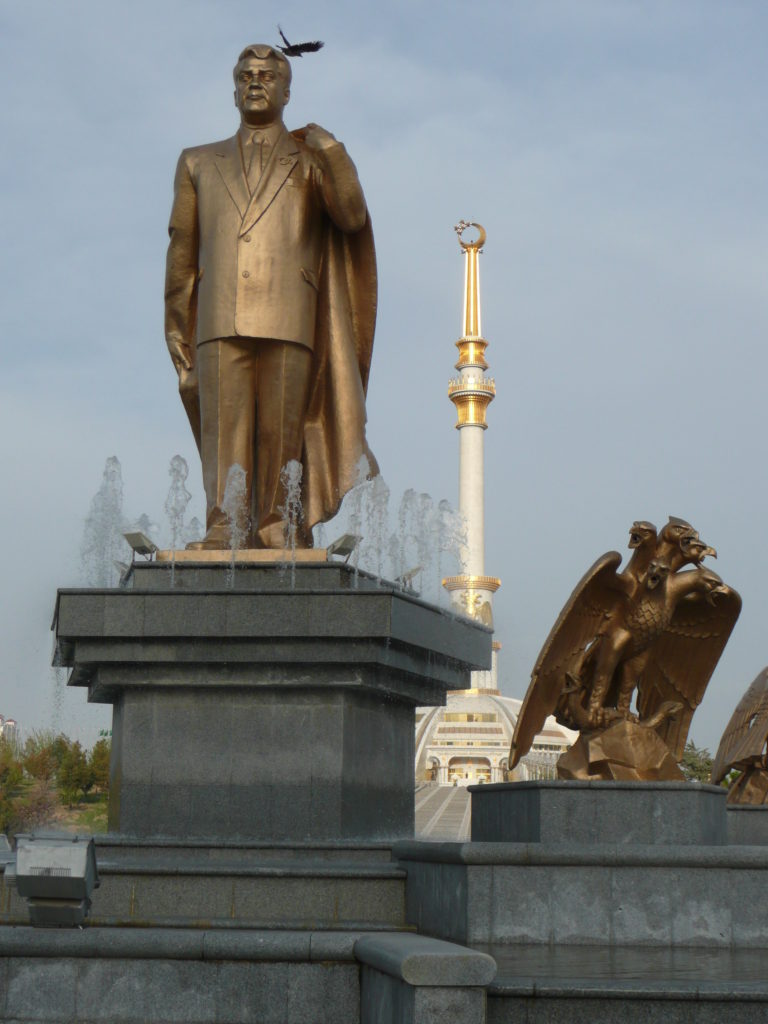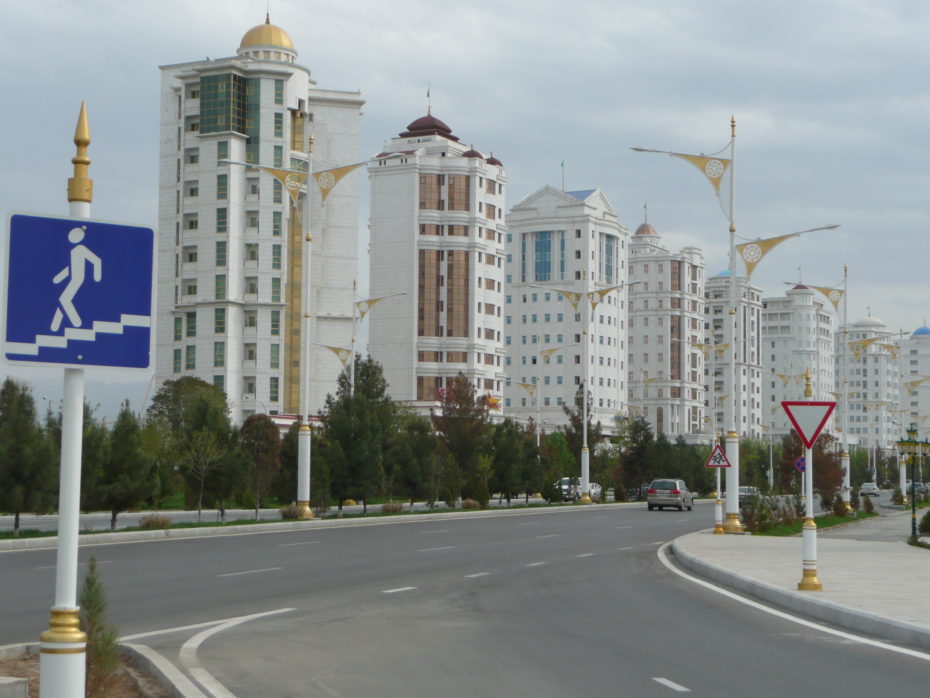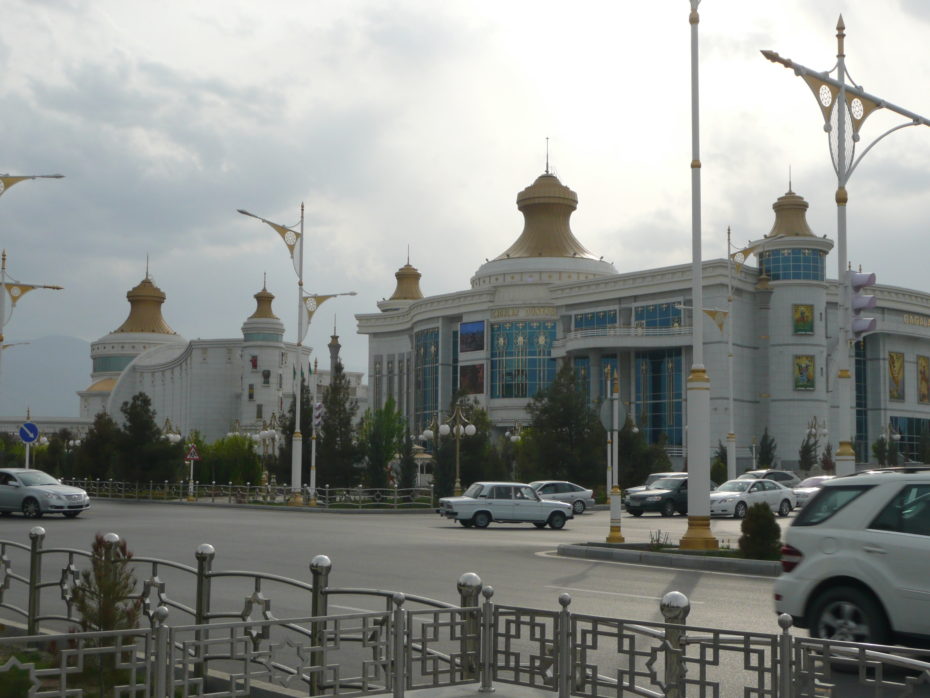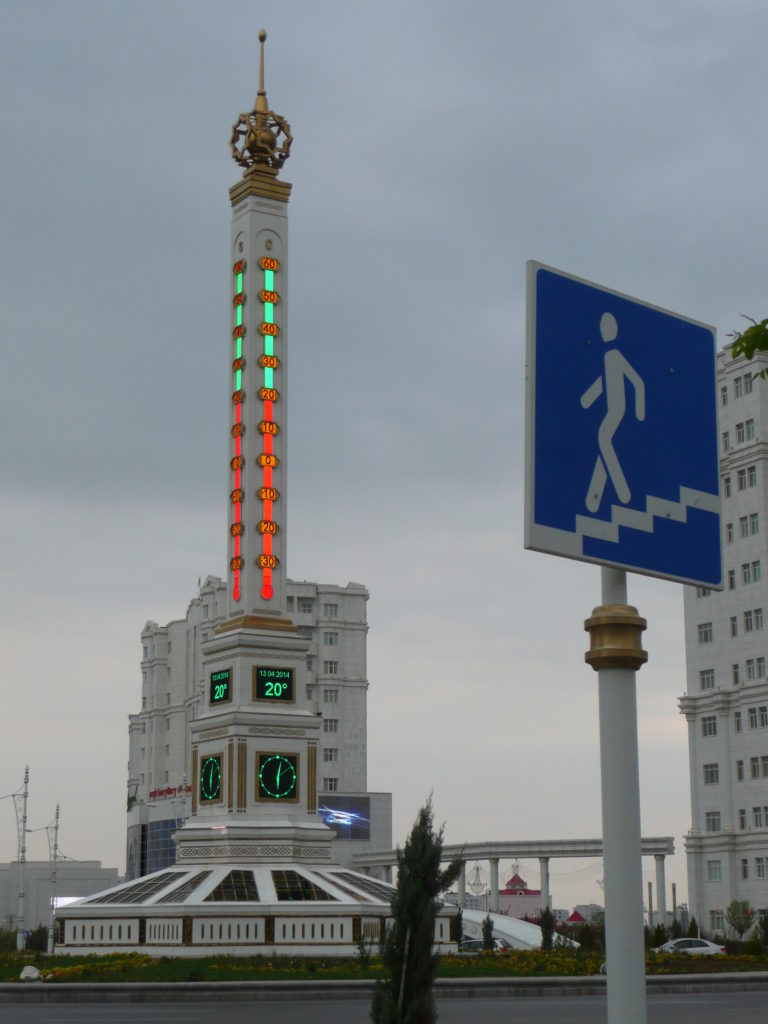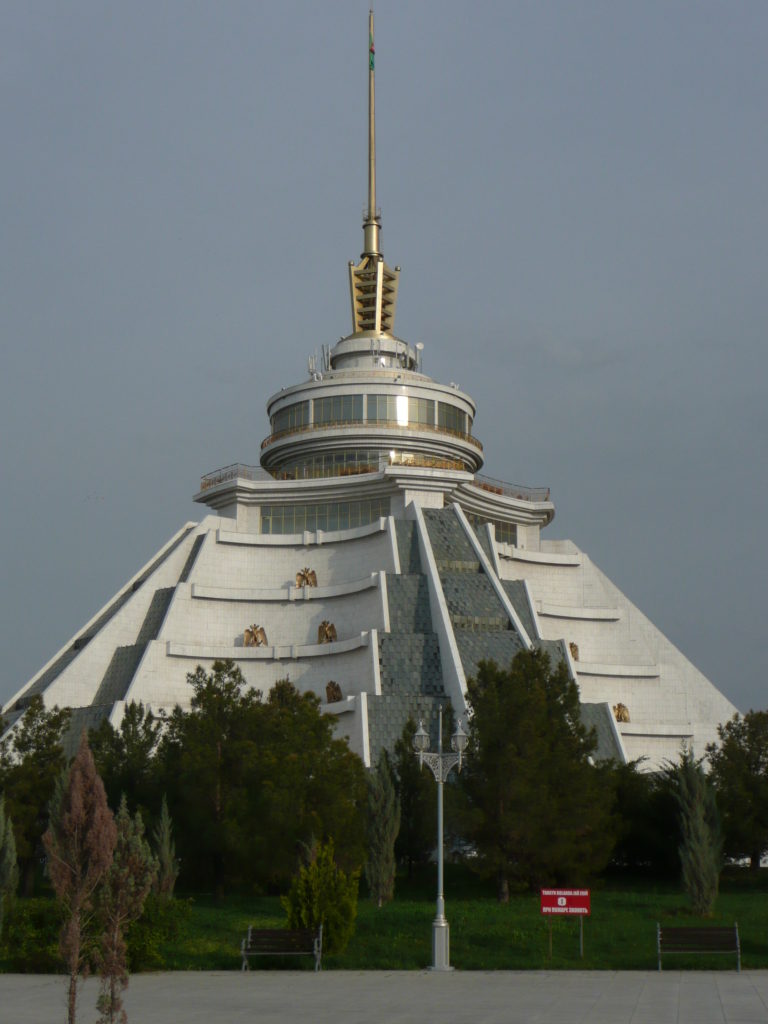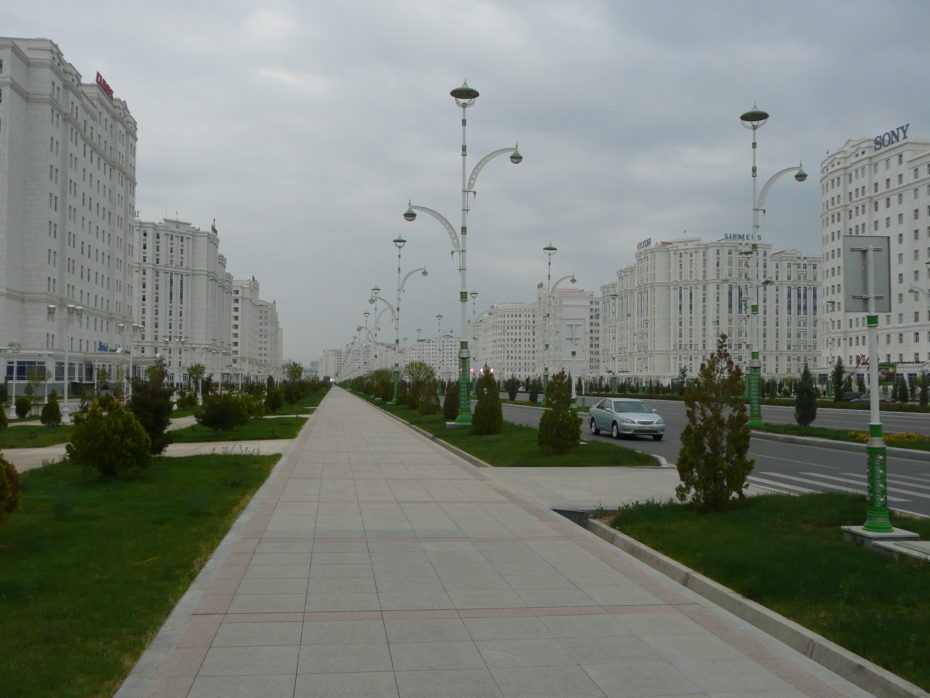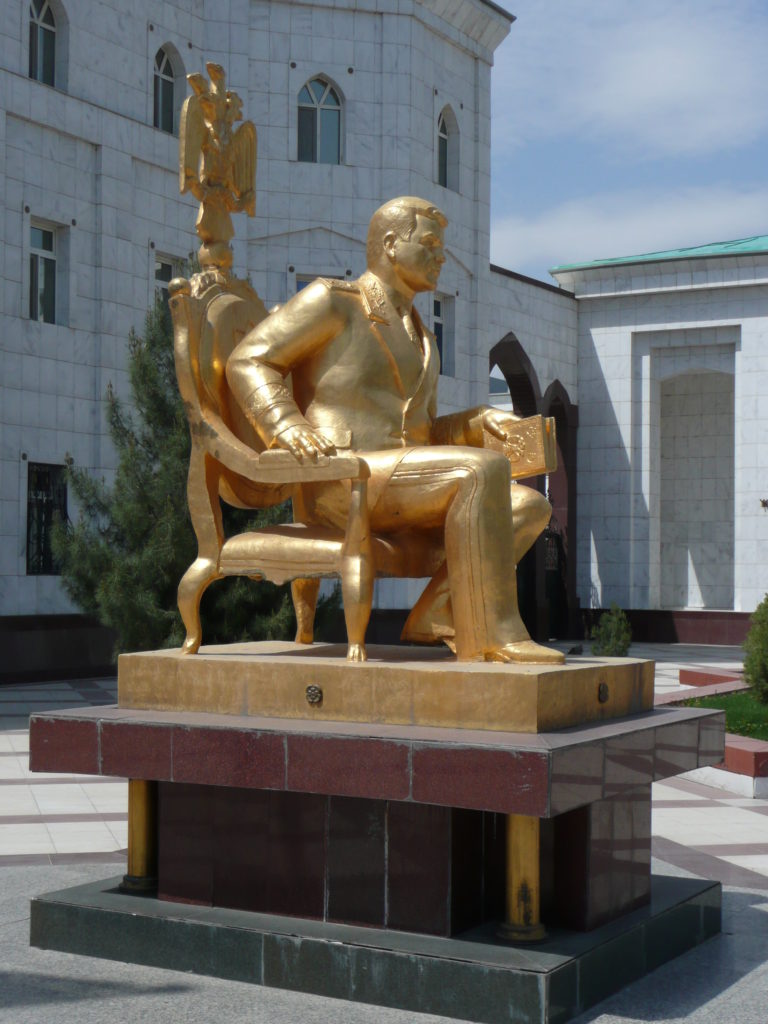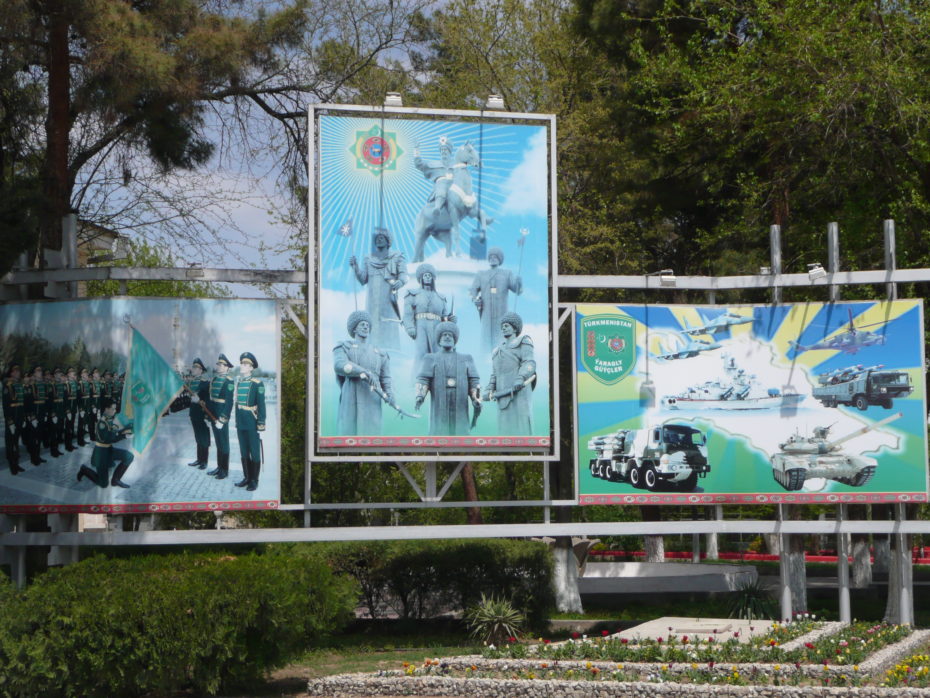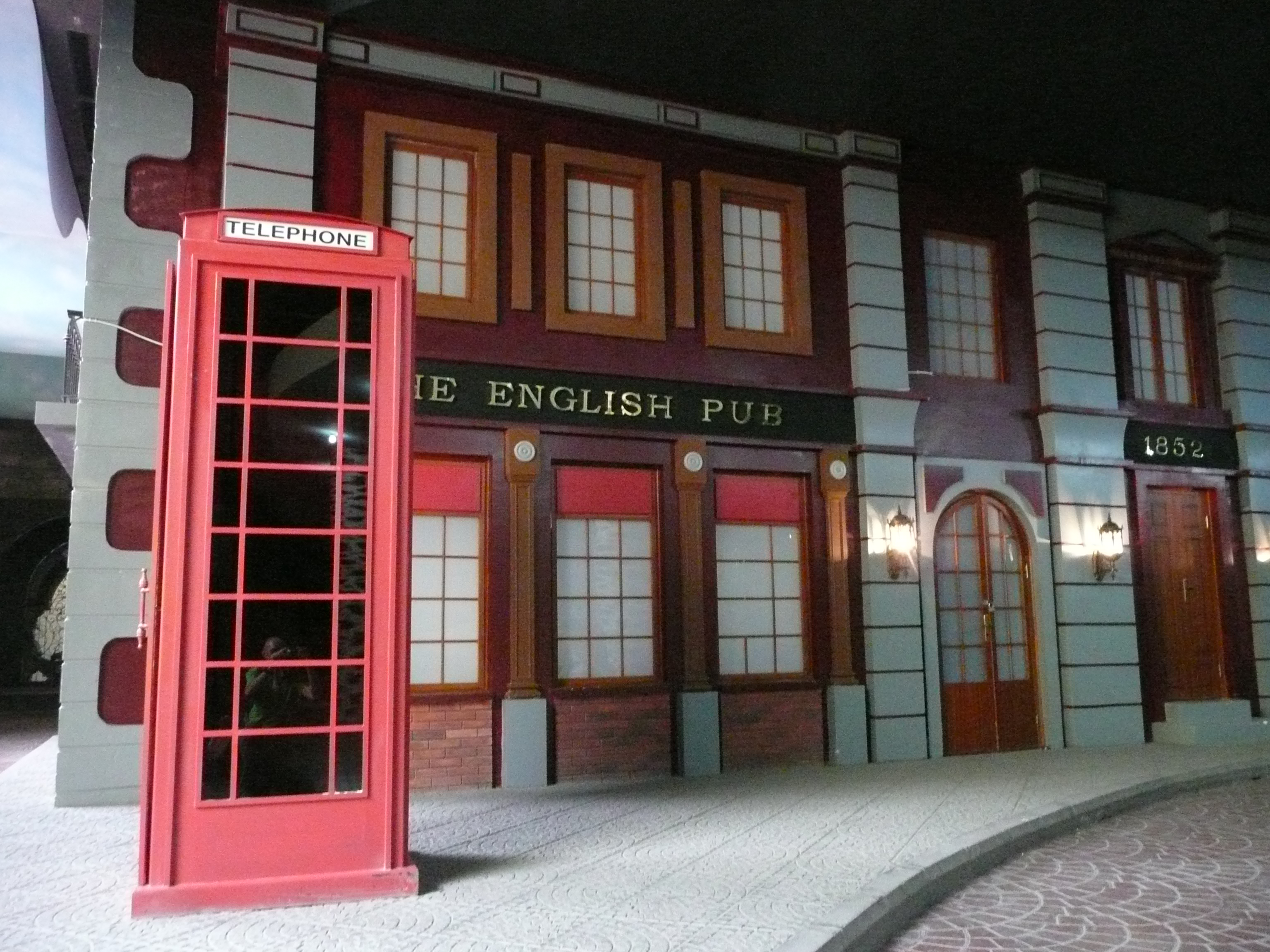One day I saw a piece of rubbish in Ashgabat. I want you to ponder on the significance of that statement: in a whole day of walking around the central part of the city I saw a single, solitary piece of rubbish. Even the Swiss couldn’t manage that! You need the single-minded determination of a dictatorship to achieve this attention to detail. It is difficult to know where to start trying to explain such a city but certainly only a dictator can have a sufficient level of creative control, unhindered by planning departments, public opinion and above all common sense. I very deliberately put this post after the previous introduction to Niyazov, as without understanding the man you have no hope of understanding the city.
Whether you are looking from a distance or close up it raises questions, gasps of incredulity or a stupefying grin. Standing back, the most glaring fact, literally so on a sunny day, is the white, every single building is of white, if not marble a facsimile. According to Niyazov, buildings of white marble, “honour the worth of the Turkmen” and “our natural and spiritual values should live in the buildings”. Then again he was full of shit, so this is in all likelihood meaningless twaddle. This coherency of vision, as an architect might say is more of a testimony to an unbridled ego and was more to honour the worth of him, rather than any of his subjects.
If there was an Ashgabat of old there is precious little evidence of it now and the few scant remains are probably scheduled for redevelopment. Everything has been done since the late 90’s and already some of this work has been demolished to make way for constructions to satisfy the ego of new president Berdimuhamedow, principally a new “Olympic Park” for the Asian Indoor and Martial Arts Games 2017.
Soviet monumentalism, given a cheery face with the white marble exteriors, dominates the design of apartment blocks but elsewhere North Korea meets Disney is often the inspiration for more important buildings, although just enough classicism is thrown in to the mix as the traditional hall-mark of authority. To be on the international map you need some Guinness Book of Records action, so with billions at hand from fossil fuel revenues the money hasn’t been wasted on health care or social services, so Turkmens can proudly boast the World’s largest thermometer and enclosed ferris wheel, both gloriously illuminated in multi-coloured neon at night. If this were not enough, the Turkmenistan Tower, one of the many pointless monuments to abstract concepts, boasts the World’s largest architectural image of an eight pointed star, allegedly.
Turkmenbashi’s first palace was deemed not impressive enough, particularly as a post war, insignificant Tajikistan had inconsiderately decided to make a bigger example, rather than feed the war ravaged nation, so they had a bigger one built next door with the requisite number of golden domes demanded of a proper dictatorship’s status. Police patrol the surrounding streets to ensure that no one actually gets close enough to disturb the purity of form, or God forbid demonstrate about anything. The simple rule for tourists is: if the building has policemen outside of it, don’t take a photo or your holiday will be immediately terminated, possibly along with your life, depending on how important your home nation is to Turkmen government interests. On the assumption that Turkmenistan could get along quite happily without British services I elected to limit my photgraphic efforts.
Closer inspection brought out quirks in the planning: virtually every one of the apartment blocks is twelve storeys high; it took an hour of fruitless searching for a shop until I discovered them hidden behind the smoked glass windows at the base of each tower; numerous HD video screens flit between patriotic images and kids cartoons. Perhaps the strangest thing is the lack of people: on my first walk I crossed two eight lane highways with no need to look as the nearest car was barely in sight; vast apartment blocks would have only a handful of children playing on the high quality facilities provided for each one, with the occasional parent overseeing them, whereas the modest, old blocks nearer the outskirts were awash with people; no students came and went from the palatial university buildings; the great edifices of government bureaucracy, surely designed for thousands of workers would only ever have a trickle of staff coming or going. With a population of about 5 million the state buildings would have sufficed for a country several times bigger.

Surprisingly they decided not to copy the leaning aspect of the original for this government building but my photography did instead
It was as if the city was an elaborate facade, but to disguise what? I can only imagine that the extravagant demands of ego and power required an awesome appearance to justify its self-importance and to send a message to the people of their own insignificance. Certainly many of those unfortunate enough to have been living in the demolished Ashgabat of old were considered insignificant enough not to be worthy of compensation for their homes, which would have hardly made an impression on the billions spent on this vast, egotistical, architectural wank fest. Where money has been spent elsewhere in the country it appears largely also for grandiose public buildings, parks with gold statues of Turkmenbashi and infrastructure to support industry, rather than for the benefit of the population at large.
Not that the government would tell you about crime figures, because officially it doesn’t exist, the drugs, prostitution, murder and robbery essential to any city’s economy do exist, despite the outward image of perfection, although tourists are unlikely to encounter it. Corruption of course starts at the very top, with the president and works its way down to the policeman on the beat, who is more interested in receiving a supplement to his wages than doing anything about any actual crime. I did make a point of bidding an effusive good day to many policemen and generally received a polite response, however on numerous occasions I was warned with a sharp blast of a whistle that I was walking on the wrong bit of pavement in the vicinity of government buildings.
Unlike other capitals in the region the refreshing sight of women in traditional dress is a common one but it is mandatory for any government job and since about 90% of jobs are provided by the state this is hardly surprise. Given Niyazov’s repetitive statements on tradition, the country’s women, more generally have resisted the trend towards western dress found elsewhere. However, his reasonings, echoing Islamic demands for modesty don’t seem to stand up to much detailed scrutiny, as the dresses are always cut tight at the waist, hence do absolutely nothing to disguise a woman’s figure. Maybe it is this which has contributed to the slimness of the Turkmen feminine form, particularly in later years, unlike neighbouring Uzbekistan where, even though the diet is similar, a ballooning tendency is much in evidence.

Cultural sensitivities limited my opportunities to take photos of women in public but these at least give you a flavour of the dress, albeit with some additional layers
Adding to the whole aura of bizarreness exuded by the city are the people themselves, everywhere else in the world I have been where tourists are exceedingly rare generated an often overt welcome or at least curiosity, but in Ashgabat and only slightly less so in the rest of the country I felt invisible. Not that anyone was unfriendly but there was almost no recognition of my existence, rare in all the surrounding countries, which share Islam and many cultural values. No one ever hurriedly looked away for fear of having engaged with the corrupting influence of a foreigner and incurring the wrath of the authorities and it has remained the one mysterious facet of this strange land I am completely at a loss to provide an explanation for.
Ashgabat is also the last place on earth where an expected to find a reminder of home. Inadvertently assuming it to be open I strolled through the open gates of an amusement park, the World of Turkmenbashi Tales, to find the usual collection of children’s rides devoid of life. Wandering into a man-made cave entrance I was confronted with the lights and sounds of machines, bright yellow spaceships and silver robots waiting only for noisy children. Following a quieter passage I turned a corner to be confronted by the life-size replica of a traditional English pub and an old-fashioned, red telephone box. So even here, there’s some dark corner of a foreign dictatorship that is forever England. (Thanks to Rupert Brooke, who knew a bit more about poetry than I ever will)




